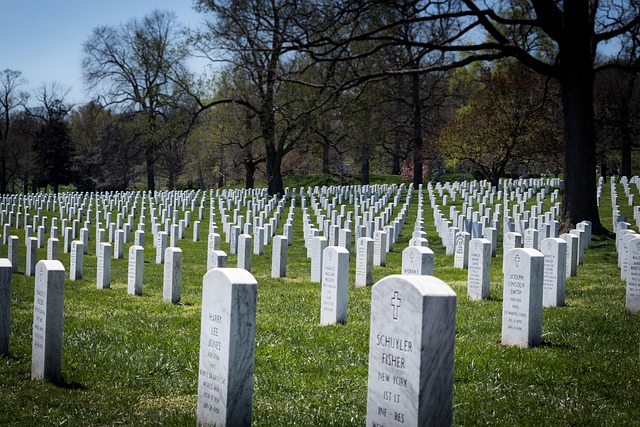Guard and Reserve Military Burial Benefits

Military burial benefits for American servicemembers are offered by the Department of Veterans Affairs (VA) and the Department of Defense (DoD) to assist families dealing with the death of a loved one.
Eligibility for these benefits may vary depending on whether the deceased was an active duty, Guard, or Reserve member. Those who qualify for military burial benefits may be entitled to:
- Burial in a VA national cemetery.
- A government-furnished headstone or marker.
- A burial flag.
- A Presidential Memorial Certificate.
- Reimbursement for burial and funeral expenses (burial allowances).
- Military funeral honors.
Members of the Guard/Reserve on Active Duty for Training (ADT), Inactive Duty Training (IDT), Full-Time National Guard Duty (Title 32), or Federal Active Duty (Title 10) all have specific eligibility requirements for federal death benefits.
Applying for military burial benefits for Guard and Reserve members requires proof of qualifying periods of military service. Unlike continuous active-duty service, Guard and Reserve members’ careers are often characterized by intermittent periods of duty, each governed by different legal authorities that can impact federal benefit eligibility.
>> Never miss a benefits update. Subscribe to the MyMilitaryBenefits Newsletter NOW.
General Eligibility for VA Burial Benefits
For federal VA burial benefits, a deceased Guard or Reserve member is generally considered eligible if they meet one of the following criteria:
Federal Active Duty (Title 10): Served on active duty (other than for training) and were discharged under conditions other than dishonorable. This includes federal activations, deployments, or extended active duty tours under federal orders. The duration of this service is often a key factor for full eligibility, with 24 months of continuous active duty (or completing the period for which they were called to active duty) being a common benchmark for many VA benefits.
Initial Active Duty for Training (IADT): Died while performing active duty for training. This specifically covers individuals who pass away during their initial training phases.
Inactive Duty Training (IDT): Died while performing inactive duty training (e.g., weekend drills).
Full-Time National Guard Duty (Title 32): Died while performing full-time National Guard duty for a period of 30 days or more, or while performing Title 32 duty in support of a contingency operation. This is a crucial distinction as most Title 32 duty is state-controlled, but these specific federal purposes or durations can trigger federal VA eligibility.
Service-Connected Disability: Was a veteran who was receiving VA disability compensation for a service-connected disability at the time of death, regardless of the length or type of their last period of active duty. This is a significant pathway for disabled Guard and Reserve veterans.
Pension Recipient: Was receiving VA pension benefits at the time of death.
Medal of Honor Recipient: Was a Medal of Honor recipient.
An honorable discharge is typically required. However, if the discharge was “other than honorable” but was due to a service-connected disability, or if the VA determines that the circumstances of the discharge do not bar the benefit, eligibility may still be possible. Families should not assume ineligibility. Consult with the VA or a Veterans Service Organization (VSO).
>> Never miss a benefits update. Subscribe to the MyMilitaryBenefits Newsletter NOW.
Federal vs. State Active Duty for National Guard
For National Guard members, the distinction between federal active duty (Title 10) and state active duty (Title 32) is important for burial benefits.
Title 10 Orders (Federal Active Duty): When the president calls a National Guard unit or individual to active duty (e.g., for deployments overseas or federal emergencies), they fall under Title 10 of the U.S. Code. Service under these orders is considered federal service and generally counts towards federal veteran benefits, including burial benefits, in the same way as active-duty service.
Title 32 Orders (Full-Time National Guard Duty): This duty is funded federally but typically controlled by the state governor. Examples include responding to state-level disasters (floods, hurricanes), border support, or specific federal missions where the Guard retains state control. Eligibility for federal VA burial benefits under Title 32 is more restricted and primarily applies if the duty was for 30 days or more or in support of a contingency operation, and the death occurred while on this duty.
If the death occurred during Title 32 duty that does not meet these federal criteria (e.g., short-term state emergency response not linked to a contingency operation), federal VA burial benefits may not apply, though state-specific benefits might be available.
State Active Duty: This is duty performed solely under state orders, funded by the state, and generally does not qualify for federal VA benefits. However, most states offer their own set of burial honors or allowances for Guard members who die while on active duty or are honorably discharged state veterans. Families should check with their respective state’s Department of Veterans Affairs or military department.
Guard and Reserve Burial in a VA National Cemetery
Eligible Guard/ Reserve veterans, their spouses, and dependent children can be interred in one of the VA’s national cemeteries.
- Benefits include the grave site, opening and closing, a government headstone or marker, perpetual care of the grave site, and a Presidential Memorial Certificate. The VA provides for interment or burial and a suitable marker for cremated remains.
- For those eligible for burial in a VA national cemetery, the grave site, opening/closing, or grave liner is free. However, families are responsible for funeral home charges, transportation of remains, and other related costs.
- It is generally not possible to reserve a grave site in advance. Burial is on an “at-need” basis, meaning space is assigned at the time of need. However, families can pre-determine eligibility by submitting a VA Application for Pre-Need Determination of Eligibility for Burial in a VA National Cemetery.
Government-Furnished Headstone or Marker
The VA provides a headstone or burial marker for eligible veterans, even if they are buried in a private cemetery.
- Options include upright headstones, flat markers, and niche covers. These are available in granite, marble, or bronze, with inscriptions that include the veteran’s name, branch of service, dates of birth and death, and typically a religious emblem.
- If the burial is in a VA national cemetery, the headstone/marker is provided automatically. If the veteran is buried in a private cemetery, the VA will furnish the headstone/marker free of charge.
- Eligibility for Guard/Reserve follows the same general criteria as for burial in a national cemetery.
A United States flag is provided for the casket or accompany the urn of a deceased veteran.
Generally, any honorably discharged veteran is eligible. This includes Guard and Reserve members who completed their initial obligated period of service in the Selected Reserve or National Guard, or were discharged from federal active duty (Title 10) under honorable conditions. The flag is issued to the next of kin or a friend.
Flags can be obtained at any VA regional office, most U.S. Post Offices, and funeral homes. VA Form 21-2008, “Application for United States Flag for Burial Purposes,” is used.
Presidential Memorial Certificate (PMC)
A PMC is a certificate signed by the current President, honoring the memory of honorably discharged deceased veterans.
- Available to the next of kin and loved ones of honorably discharged deceased veterans. Eligibility requirements align with those for VA burial benefits in typical cases.
- Families can apply by submitting VA Application for Presidential Memorial Certificate, along with proof of honorable military service and death.
Burial and Funeral Expense Reimbursement (Burial Allowances)
The VA may pay a burial allowance and a plot or interment allowance to reimburse families for eligible veterans’ burial and funeral expenses.
Service-Connected Death: If a veteran’s death is service-connected, the VA may pay a burial allowance of up to $2,000. If buried in a VA national cemetery, some or all of the cost of transporting the veteran’s remains may be reimbursed.
Non-Service-Connected Death: For non-service-connected deaths, the VA may pay a burial allowance (currently $300) and a plot or interment allowance (currently $300) if the veteran was receiving VA pension or compensation at the time of death, or died in a VA facility, or died while being transported at VA expense to or from a VA facility.
Military Funeral Honors
The DoD’s Military Funeral Honors program ensures that every eligible veteran receives a funeral honors ceremony. This detail performs a ceremony that includes folding and presenting the U.S. flag and playing “Taps.“
- Generally, all honorably discharged veterans are eligible, including members of the National Guard and Reserve who:
- Served a period of federal active duty and were discharged under honorable conditions.
- Completed at least 20 years of service in the National Guard or Reserves, were entitled to retired pay (even if they had not yet begun receiving it), and were discharged under honorable conditions. These are commonly referred to as “gray area” retirees.
- The funeral director usually arranges Military Funeral Honors at the family’s request.
- The family should inform the funeral director of the veteran’s status and provide documentation.
Importance of Documentation
Without proper records, proving qualifying service can be challenging.
Essential Documents include:
- DD-214, Certificate of Release or Discharge from Active Duty: This form is the primary document for veterans who served on federal active duty (Title 10). It certifies honorable service and separation.
- NGB Form 22, Report of Separation and Record of Service (National Guard): This form is for National Guard members and documents federal and state active duty periods. It is crucial for verifying periods of Title 32 duty.
- NGB Form 23, National Guard Retirement Points Accounting Statement: This statement documents a National Guard member’s retirement points, which are vital for proving eligibility for military funeral honors as a “gray area” retiree (20 years of creditable service).
- VA Eligibility Letter/Decision: If the veteran received VA disability compensation or pension, documentation of this benefit is critical.
- Official Duty Orders: For periods of active duty for training (ADT), inactive duty training (IDT), or specific Title 32 orders, the actual orders (e.g., DA Form 1379, orders authorizing specific training) are invaluable.
- Line of Duty (LOD) Determinations: If the death was related to an injury or illness sustained during ADT, IDT, or Title 32 duty, the formal “Line of Duty” determination from the military service is essential for proving service connection.
- Marriage Certificate/Birth Certificates: For spouses and dependent children seeking interment in a national cemetery.
- Death Certificate: Required for any burial benefit application.
Families should keep original or certified copies of these documents in a safe and accessible place. If documents are missing, the National Archives and Records Administration (NARA) can assist in obtaining military service records.
Service-Connected Deaths
When a Guard or Reserve member’s death is determined by the VA to be service-connected, additional benefits become available. A death is service-connected if it was caused by a service-connected disability or an event that occurred during qualifying military service. Benefits for service-connected deaths include:
- Dependency and Indemnity Compensation (DIC): A tax-free benefit for eligible surviving spouses, children, or parents of servicemembers who died on active duty or veterans whose death was service-connected.
- Higher Burial Allowance: As noted, up to $2,000 for burial and funeral expenses.
- Reimbursement for Transportation: Reimbursement for the cost of transporting the remains to a national cemetery.
These benefits support to families facing the profound loss of a loved one whose death was a direct result of their military service.
State-Specific Benefits for National Guard
Many states offer burial benefits for National Guard members who may not qualify for all federal benefits, particularly for those whose service was predominantly state active duty. These can include:
State Veterans Cemeteries: Many states operate their own veterans’ cemeteries, often with more lenient eligibility criteria that encompass broader state active duty service.
State Burial Allowances: Some states provide a modest burial allowance to assist with funeral costs for eligible state veterans.
State Funeral Honors: State National Guard components often conduct their own funeral honors for Guard members who may not meet federal criteria (e.g., those who did not have federal active duty or sufficient federalized time).
Families of National Guard members should always inquire with their state’s Department of Veterans Affairs or National Guard Bureau to understand all available state-level benefits.
>> Never miss a benefits update. Subscribe to the MyMilitaryBenefits Newsletter NOW.
About the author
Editor-in-Chief Joe Wallace is a 13-year veteran of the United States Air Force and a former reporter/editor for Air Force Television News and the Pentagon Channel. His freelance work includes contract work for Motorola, VALoans.com, and Credit Karma. He is co-founder of Dim Art House in Springfield, Illinois, and spends his non-writing time as an abstract painter, independent publisher, and occasional filmmaker.


